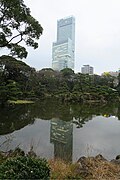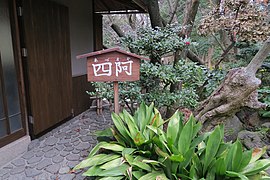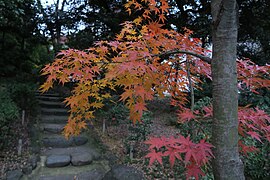Keitaku garden
The Keitaku Garden ( Japanese 慶 沢 園 , Keitaku-en ) is a small public complex in Osaka that was once the garden of the Sumitomo family.
Overview
The 15th head of the Sumitomo family, Sumitomo Tomoito (住友 友 純; 1865–1926), arranged for a garden to be laid out in his residence on Cha'usu Hill (茶 臼 山) in Osaka. Was assigned Ogawa Jihe (小川治兵衛; 1860-1933), a known garden designers of his time. The garden got its name from Prince Fushimi Sadanaru .
The garden, around a large pond, is a modern version of the classic changing garden ((式, Kaiyū-shiki). In the north a small waterfall leads to water, on the southern edge of the pond, which contains some islands, a stony beach (州 浜, Suhama) spreads out. In two places, bookings are crossed by stone beam bridges (切 石橋, Kiri-ishibashi).
In addition to the entrance to the park on the south-east side, there is another (closed) gate on the south-west side, which used to belong to a Fujita residence. A pavilion on the east side of the pond called "Azumaya" (四 阿) invites you to relax. On the west side there is a pavilion for the tea ceremony , which bears the name Chōsei-an (長生,), meaning “pavilion of long life”.
With trees made up of plum, cherry and maple, complemented by azaleas, irises and water lilies, the garden has a different color every season. Selected stones in the shape of a dragon or boat also characterize the garden.
photos
View of the Osaka Art Museum
Remarks
- ↑ Ogawa designed the gardens for Heian-jingū , Furukawa Garden , Maruyama Park and the garden of Sanzen-in , among others .
- ↑ View of the 300 m high Abenobashi Terminal Building Tower, completed in 2014 (阿 部 野 橋 タ ー ミ ナ ル ビ ル タ ワ ー 館).
literature
- Leaflet of the garden, Japanese and English.
Coordinates: 34 ° 38 ′ 58.8 ″ N , 135 ° 30 ′ 41.6 ″ E





